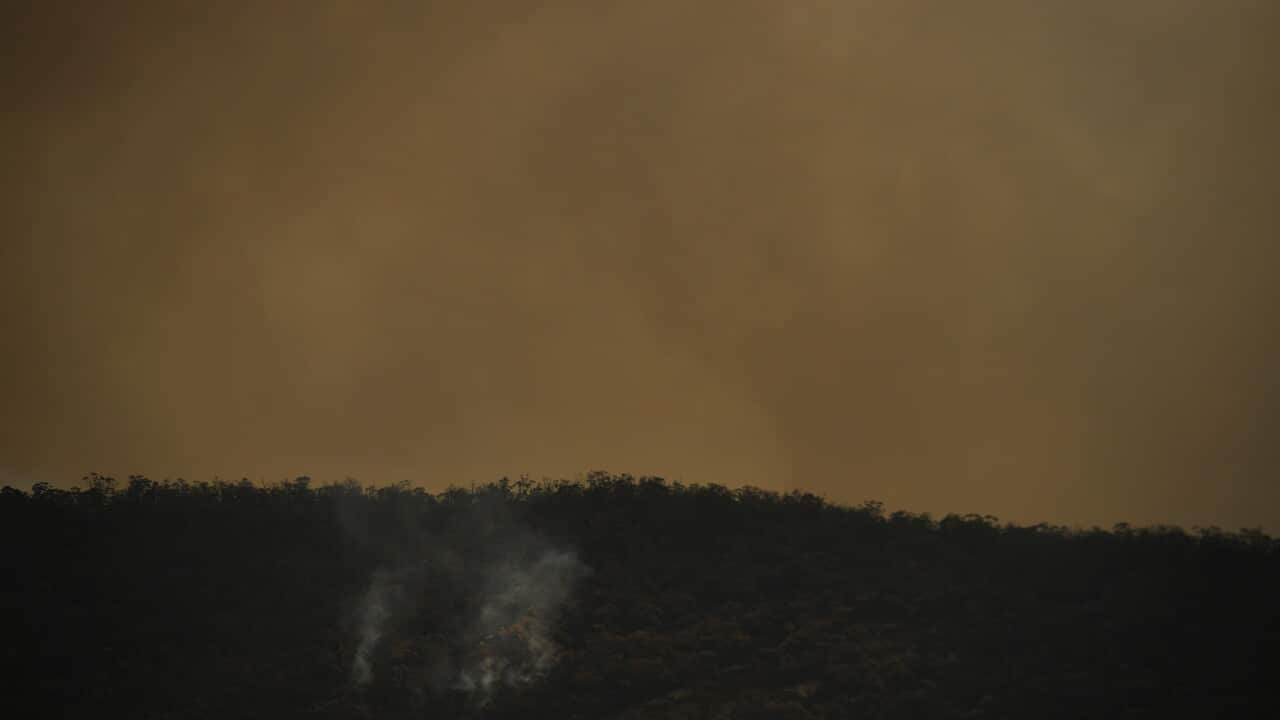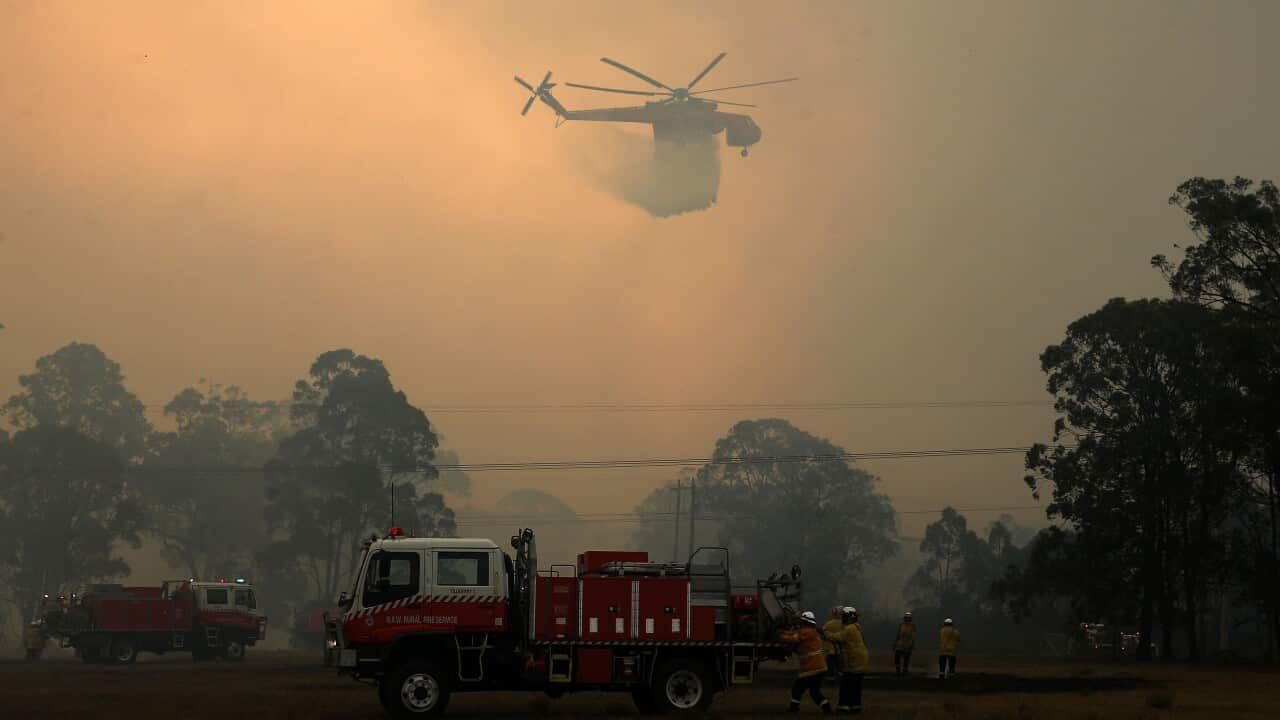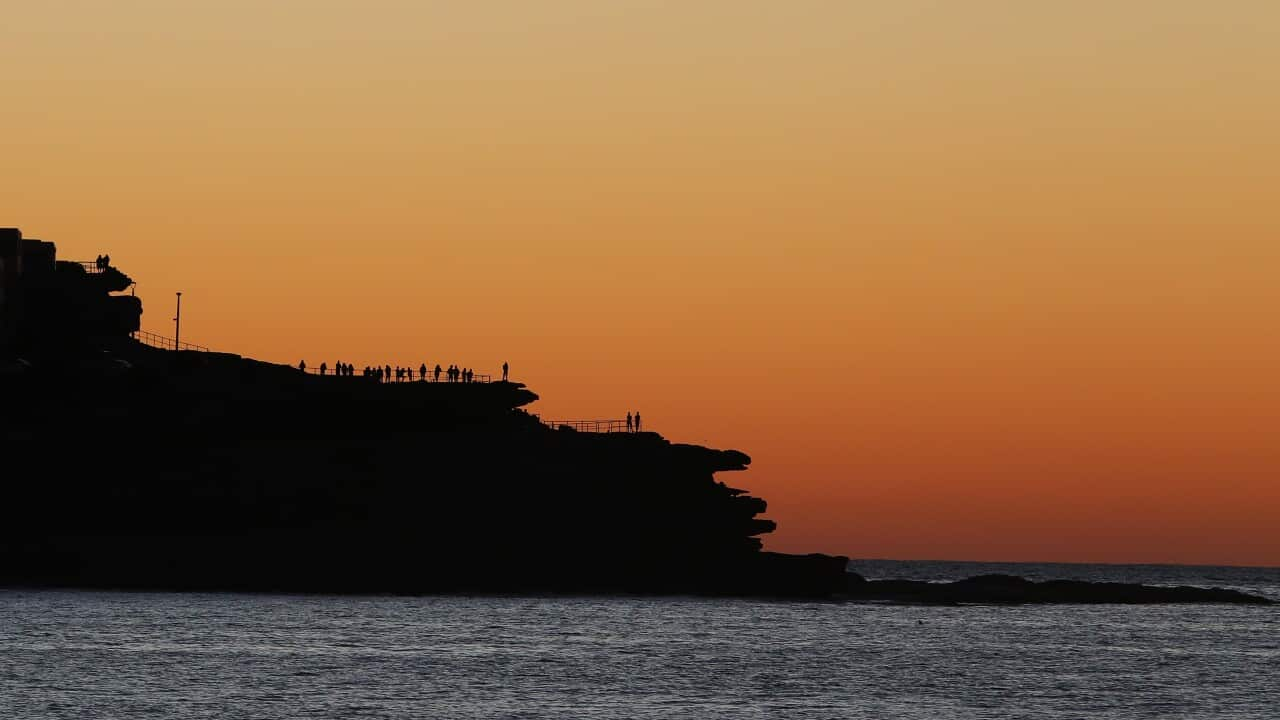

14 min read
Feature
It was an ordinary December for these Aussies. Then it turned 'Armageddon'
The sky in Mallacoota turned red and black. Finally, the navy came to rescue "lost souls" on the beach amid one of the worst Australian bushfire seasons on record.
Published 12 December 2024 5:43am
Updated 22 December 2024 9:22am
By Madeleine Wedesweiler
Source: SBS News
Image: Mary O'Malley and Larry Gray were among the self-described "Mallacoota Nine" during the Black Summer bushfires. (SBS News / Madeleine Wedesweiler)
The week after Christmas 2019, was predictably quiet in Mallacoota — only the sound of family and friends and the usual cicadas and birdsong were memorable, according to Mary O'Malley and Larry Gray.
The bush looked overgrown and dry but otherwise normal.
Mary and Larry’s adult son had invited friends to camp on their property in the small coastal township in East Gippsland, Victoria, expecting to relax and swim away the hot days as December ticked over into January.
Nobody was prepared for what Mary now describes as "Armaggedon".
You could hear the fires long before you could see them.
"It sounded like bombs going off. It really sounded like it was a war," Larry says.
They would later learn the bomblike explosions were lightning strikes generated by bushfires that tore through large parts of East Gippsland — so hot they created their own weather systems.
One blaze, which had started at Banana Track north-west of Mallacoota, had been making its way south since November, closing off the one road in and out of town.
LISTEN TO

1. Burnt: No Ordinary Fire
SBS News
12/12/202428:21
At 4.40pm on 30 December, residents received an evacuation warning via text, urging them to take shelter.
Without an evacuation plan or any option to leave, the self-described "Mallacoota Nine" — Mary, Larry and seven young people, including their son and his friends — rushed down to the waterfront.
As is usual at that time of year, thousands of tourists were camped by the shore. Fishing boats and caravans became emergency shelters.
"Larry knew this spot that he thought was the safest place to be down on the lake. And we ended up there with, on this tiny little jetty, all of us in a row sitting really uncomfortably, no proper clothing on, no long sleeves," Mary says.

The waterfront is typically populated by thousands of tourists in summer. Source: SBS News / Sydney Lang
They only had a loaf of bread to share between them.
That evening, the sky turned orange, then a deep, dark red.
Larry says when he woke up at the jetty on New Year's Eve, the horizon was glowing.
"It was as red as you could possibly find a red anything. And it was like, we're on another planet for a while, and the noise was getting louder, and then it went black."
It was the darkest black, like dipping your hand into ink.Larry Gray
As smoke and ash cloaked the town, it became so dark people couldn't see the ground below their feet, but it didn't go silent.
"We could hear the screaming of animals dying and gas bottles exploding, and people were thinking 'What the f--k's going on?’" Larry says.
Information was fractured — people didn't know that by that point, the fire had reached the outskirts of town, but a change in wind direction meant it narrowly missed its centre.

The sky turned orange as fires ripped through East Gippsland in 2019 and 2020's Black Summer disaster. Source: Getty / Darrian Traynor
For days, around 5,000 people couldn't leave.
Roads were melted, blocked by smoking trees and rendered invisible by thick grey smoke.
"There's no fuel, there's no water. So you turn a tap, nothing comes out of it. And the electricity's gone," Larry says.
As the crowd waited for the fires to burn out, Mary says it felt as though they were "lost souls" just existing at the jetty, mourning the nature destroyed around them.
"It had all just gone in one day. Just washed up animals dead everywhere," she recalls.
"So that was really hard. You come here to live amongst all that nature and suddenly it's not even a leaf."
The pair didn't know at that point that the fire had damaged their property.

On 3 January 2020, evacuees walked to the beach to board vessels that would ferry them to the navy's HMAS Choules in Mallacoota. Source: Supplied / Australian Defence Force
Staff had given up their holidays to spend just 16 hours preparing the ship for around 1,000 people, who by then had gathered at Bastion Point.
But not everyone could board.
"We put our names down, and it was like wartime," Mary says.
"I remember you had to get in a queue, and they had all these pieces of paper around the wall, and you had to find out if your name was on there for the ship.
"It was a really long queue. So I said to my son's friend, who was much taller than me, 'Just go and peer over the heads of other people.'"
Their names were on the list. They were expecting the ship to be cramped and unpleasant, but it wasn't: The largest naval evacuation in Australia's history was quite comfortable.

Around 1,000 people were evacuated from Mallacoota by the Australian Navy, making a 20-hour journey to the Port of Hastings. Source: Supplied / Mary O'Malley
"There were dogs and cats howling amongst all this army equipment. It was really weird, but it was good."
It took 20 hours to make the journey south to the Port of Hastings, just east of Melbourne.
People were exhausted — Mary says she couldn't stop crying or function normally. It would be a while before anyone could properly process the surreal journey.
Covered in ash, the couple were grateful when friends from Melbourne came to pick them up.
"Our friend was taking us around the house, and he kept saying over and over, 'There's a shower over that way, and a shower down there and an outside shower,'" Larry recalls.
"I said, 'Am I on the nose?' He said, 'Oh, you f—king stink'. Well, we hadn't washed."
They then flew to Sydney for a few weeks before making the traumatic 600km return journey by car to Mallacoota — the land along the entire highway had been burned and was still smoking.

Bastion Point five years later. Source: SBS News / Madeleine Wedesweiler
Five years later, communities are in various stages of recovery and many are anxious Australia didn't learn enough from the disaster.
Around three billion vertebrate animals were killed, established afterwards.
An estimated 24.3 million hectares burned across the country — roughly the size of the United Kingdom.
Thirty-four people were killed by fire, another 445 died from smoke inhalation, and nearly 3,500 homes were destroyed.
The Climate Council estimates around 80 per cent of Australians were affected in some way, as
While the worst of the damage happened over the summer months, Black Summer actually started in July in Port Macquarie, NSW.
The majority of fires burned between September 2019 and February 2020, though some continued into March.
Sparsely populated parts of the Northern Territory and Queensland experienced some of the largest fires, as well as heavily populated parts of the east coast of Queensland, NSW and Victoria.
Alen Slijepcevic is the deputy chief officer of Victoria's Country Fire Authority (CFA), the state's volunteer fire service responsible for firefighting and suppression.
He says they had "pretty spot on" predictions in 2019 that years of drought and hot, dry conditions would pose a catastrophic risk, and they were accurate about the locations.

The wharf at Bastion Point where the Mallacoota Nine boarded the HMAS Choules, in Australia's largest naval evacuation. Source: SBS News / Madeleine Wedesweiler
"After 2009, we enacted a significant program of changes to training, our systems and public warnings," he says.
"In 2019-20, we were utilising things we learned a decade earlier, and we've since been looking at what we can do to improve in that space".
Alen points out that only 2 per cent of fires that summer in Victoria got out of control, which is around the international average.
There is no jurisdiction in the world that can deal with the fire load we are getting in big seasons.Alen Slijepcevic
"We are working as hard as we can to deal with as many as we can, but if you have a massive lightning storm that will start 50 new fires, we can't get to all of them," Alen says.
"It's just a function of terrain, fuels, ease of access and the number of resources that you can put in those remote areas."

The Australian Fire and Emergency Service Authorities Council's bushfire outlook for 2024 shows an increased risk of fire in large parts of the country. Source: Supplied / AFAC
"Pyrocumulonimbus clouds or fire-generated thunderstorms were a feature of the 2019–20 fire season, and the number of these clouds recorded was an Australian record for one season," the CFA's Black Summer report found.
Rob Rogers is the commissioner of NSW Rural Fire Service (RFS) and says that based on how fires have changed in the last 60 years, he believes "they will get worse".
One of Rob’s peers, RFS volunteer Samuel McPaul, was killed on 30 December 2019 when a firetruck he was standing on flipped over due to high winds.
"If you think about a truck that's more than 10 tonnes getting flipped over by wind, that's something we certainly hadn't seen before," Rob says.
"It's really important that we continue to improve what we do and not rest on our laurels and say, 'Yeah, job's right.' It's not."
Rob says people caught up in fires can't expect them to behave in the way fires did decades ago.
"You've got obviously a lot of noise being created by the fire and wind. So it's pretty terrifying for firefighters that are in those areas. But I think even more so for residents that are caught in those areas because at least the firefighters have some level of understanding of what fire can do."
Rob says residents aren't prepared for unpredictable circumstances, for example, "incredible wind-driven fires at 3.30 in the morning", which happened during Black Summer and in some instances since.
"We unfortunately have seen some events where some people lost their lives because they did what they would've done in any other sort of fire season and it just didn't become something that was survivable unfortunately."

The burned scrub in Mallacoota has grown back, though the burned dead bits are still visible. Source: SBS News / Madeleine Wedesweiler
"We're now looking at how we can deliver more with less workforce into the future because fatigue is becoming real, and we're dealing with more and more concurrent emergencies, for example, floods and fires happening at the same time."
The royal commission recommended the CFA simplify its fire-rating systems and increase prescribed burns, which it has.
Last year, the CFA reported its "best year ever" in terms of the amount of land covered in prescribed burns.
But the practice has a variety of detractors — who we'll speak to later in this three-part series.
Driving through East Gippsland, you can see trees with blackened trunks now sprouting vibrant green leaves, surrounded by young saplings.
These sights reflect the complex experiences of the people who live in the area — each stage, before, during, and after the fires, is a distinct reality they somehow have to navigate.
Carol Hopkins is the chair of the Mallacoota and District Recovery Association (MADRA), and she says the town and the organisation still have a lot of recovery work to do five years on.
"The big buzzword now is resilience, and I kind of think that in a recovering community, it takes us a while to be ready for that conversation."
The journey from recovering into becoming more resilient is a really tricky one.Carol Hopkins
Carol explains this is because people can be reluctant to talk about the fires, let alone reflect on how they've recovered or are preparing for the next one.

Some residents in Mallacoota are anxious about fuel loads this summer. Source: SBS News / Madeleine Wedesweiler
The MADRA members were elected by Mallacoota locals in early 2020 in a bid to put the recovery process in their own hands.
Carol says that the decision has been "very powerful".
"We didn't have a voice as a community in the past. We were remote, we were little; we're a long way from anywhere. And the community didn't really feel as though they were heard."
We definitely are heard now.Carol Hopkins
Carol says people in the area now have a better understanding of themselves "as a community".
"We have a sort of collective understanding about why we live here, what we love about living here and what that actually means.
"We really did pull together brilliantly as a community to support each other and to advocate for ourselves and to be clear about what we wanted and get that written into a recovery plan and give people a voice about what was in the recovery plan."
But, many Mallacoota residents feel services and government support have been withdrawn too soon.
"I don't think people understand how long recovery takes," Carol says.
She points to emergency response staff who were hired on six-month contracts, meaning new people had to be hired and trained "from scratch" twice a year.

A log sculpture has been installed as a tribute to the defence forces, emergency services, and volunteers who protected Mallacoota during the Black Summer. Source: SBS News / Sydney Lang
Mary says she "threw herself into helping the community" after the fires but got burnt out.
"You just try to do too much and change too much and fix too much. And you realise you can't," she says.
"I think we are sadly very well-versed in all aspects of fire, including the aftermath and how to care for people, what people need.
"Everyone's on a different timeframe, and you can't just tell someone, 'Well, it's time to get over it' because it's like grief — it's not linear."
This summer, the National Council for Fire and Emergency Services has told Australians to prepare for an increased risk of fire in many parts of the country.
Soil moisture levels are below average across much of southern and eastern Australia, and fuel loads have also increased.
Maximum and minimum temperatures over summer are very likely to be above average in most states and territories.
However, parts of eastern Australia, particularly in Queensland, can expect increased chances of unseasonally high rainfall.
Larry says people in Mallacoota are worried by how thick the bush is this summer.
"When I was a kid living here, I used to have a dirt bike. I used to ride down all kinds of trails, and you could access everywhere. Now they're just overrun with trees and bushes."
We've mismanaged the bush. It didn't have to happen like this.Larry Gray





